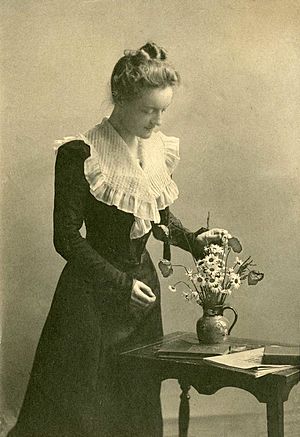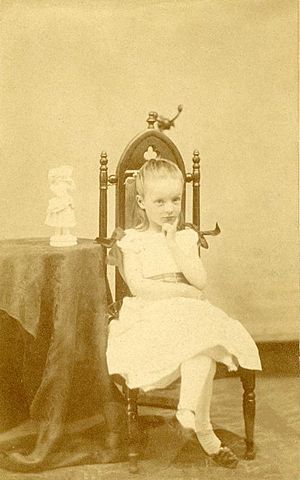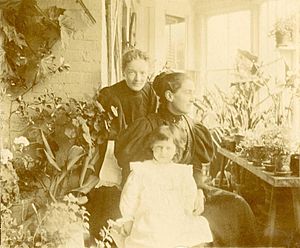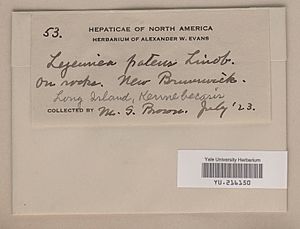Margaret Sibella Brown facts for kids
Quick facts for kids
Margaret Sibella Brown
|
|
|---|---|
 |
|
| Born | March 2, 1866 Sydney Mines, Nova Scotia
|
| Died | November 16, 1961 (aged 95) |
| Nationality | Canadian |
| Known for | Contributions to bryology |
| Awards | Master of Arts (honoris causa), Acadia University (1950) |
Margaret Sibella Brown (born March 2, 1866 – died November 16, 1961) was a Canadian scientist. She was a bryologist, which means she studied tiny plants like mosses and liverworts. These plants are common in her home province of Nova Scotia. Even though she didn't have a formal science degree, she became a respected expert. Her work helped us learn a lot about the mosses and liverworts of Nova Scotia. Today, many of the plant samples she collected are kept in important plant collections (called herbaria) around the world.
Contents
Early Life and Family
Margaret Sibella Brown was born on March 2, 1866, in Sydney Mines, Nova Scotia. She had a twin sister named Elizabeth. She also had three younger siblings: Annie, Richard, and Lillian.
Margaret's grandfather, Richard Brown, moved to Nova Scotia from England in 1825. He worked as an engineer in the coal mines and later became their general manager. Margaret's father, Richard Henry, also worked in the mines. He became the general manager when his father retired. Richard Henry married Barbara Davison, and they lived in Sydney Mines. Her father was also the town's first mayor.
Education
Margaret Brown went to school in Halifax, Nova Scotia. She attended the Anglican School for Girls and Kings College. She earned a bachelor of arts degree there.
After that, she traveled to Europe. She studied at a finishing school in Germany from 1883 to 1884. She also spent time studying in London, England. When she came back to Nova Scotia in 1885, she continued her studies at the Victoria School of Art and Design. This school is now known as NSCAD University.
Her Scientific Work
As a bryologist, Margaret Brown spent most of her time collecting and identifying mosses and liverworts. These are small, non-flowering plants. Most of her research focused on plants found in Cape Breton, Nova Scotia. However, she also collected specimens from other places like Trinidad, Puerto Rico, Spain, France, and Jamaica.
During Margaret Brown's time, it was not common for women to be scientists. Because of this, there aren't many records from her time about her scientific work. Still, she managed to publish at least eight scientific papers. Her first paper, published in 1932, described a new type of moss. In 1936, she published a large list of all the mosses and liverworts found in Nova Scotia. She also helped categorize moss samples collected by another scientist in Syria.
Margaret Brown worked with other famous scientists of her time. She went on an expedition to Puerto Rico in 1922 with Elizabeth and Nathaniel Britton. They spent ten weeks collecting plant samples there.
Groups and Boards
Margaret Brown was a member of several important scientific groups. She belonged to the Moss Exchange Club, which later became the British Bryological Society. She was also part of the Sullivant Moss Society, which is now the American Bryological and Lichenological Society. She even served as the president of the Halifax Floral Society. When she passed away at 95, she was the oldest living member of the Nova Scotian Institute of Science.
Besides her scientific work, Margaret Brown also helped her community. She was on the board of the Victoria School of Art and Design. During World War I, she was an important secretary for the Halifax branch of the Canadian Red Cross Society.
Awards and Recognition
Margaret Brown received special honors for her contributions to science. In 1950, when she was 84 years old, Acadia University gave her an honorary Master of Arts (M.A.) degree. They also offered her an honorary Ph.D., but she chose the M.A. instead. The university noted that she was "probably the chief Maritime authority on mosses and liverworts." This means she was the top expert in the region.
In 1934, she also received an honorary diploma from the Victoria School of Art and Design. In 2010, Margaret Brown was honored by being added to the Nova Scotia Scientific Hall of Fame.
A paper presented in 1976 listed Margaret Brown as one of the most important North American moss scientists and collectors. It said she made a lasting impact on the study of mosses.
Plant Collections
Margaret Brown's collection of plants is very valuable. The E.C. Smith Herbarium at Acadia University holds many of her specimens. This includes 1,779 mosses, 858 liverworts, and 53 lichens.
Other plant samples she collected are kept in major collections around the world. These include the British Museum, New York Botanical Garden, Dalhousie University, the New Brunswick Museum, the Nova Scotia Museum of Natural History, the Devonian Botanical Garden at the University of Alberta, the Yale University Herbarium, and the Harvard University Herbaria.
Death
Margaret Brown passed away at her home in Halifax on November 16, 1961. She was 95 years old. Some records show her death date as November 15, but her official death certificate confirms November 16.
Her middle name is sometimes spelled Sibella, Sybella, or Sebella. In this article, we use Sibella because it's the most common spelling in scientific records about her.
Images for kids
See also
 In Spanish: Margaret Sibella Brown para niños
In Spanish: Margaret Sibella Brown para niños








